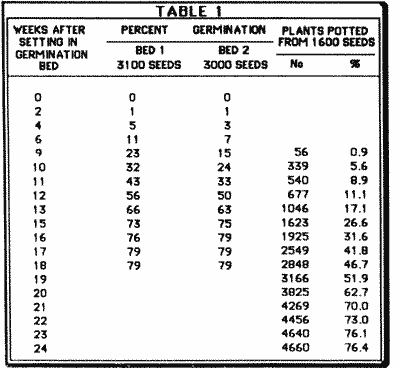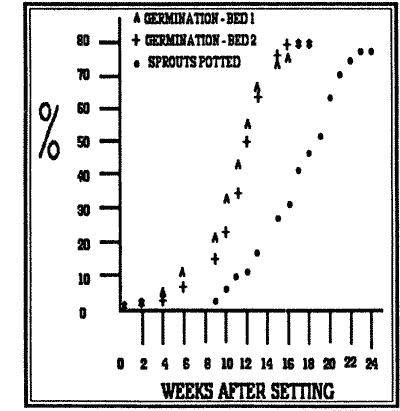
GERMINATING THE MALAYAN DWARF
SCIENTIFIC NAME: Cocos nucifera
FAMILY: Arecaceae
The speed of germination of coconut seeds, and the final percentage of out-turn of successful plants, varies between different coconut varieties.
In general, seeds of the Niu Kafa type of coconut, e.g. Jamaica Tall, require 8 - 10 weeks before any sprouts are seen. Niu Kafa coconuts have long triangular fruits with oval nuts. Due to their long germination period, they were able to survive long trips in galleons from India/Sri Lanka around the Cape of Good Hope to West Africa; then in stages to the Cape Verde Islands, and thence to the West Indies and the Atlantic coast of America. The Niu Vai type, on the other hand, have large spherical fruits and nuts, and germinate quickly. It is believed that they were moved by man eastwards across the Pacific from island to island and are now the main coconut type on the Pacific coast of Mexico, Panama and Peru. Both Niu Kafa and Niu Vai types comprise tall varieties; some 90% or more of their seeds germinate into successful seedlings.
The Malayan Dwarf is thought to have developed from a tall variety by mutation. It germinates quickly (some are beginning to sprout as they are harvested), but the percentage of successful plants is usually only 60 - 70%. Some of the failures produce only a shoot, some only roots, some remain stunted, but most of the failures do not germinate at all; the reason is not known.

Table 1 relates to an importation of Green Malayan Dwarf seeds to my farm in early 1990. The selected mother-palms in Jamaica are harvested about every two months, at which time one to three bunches are cut off each palm. This means that the physiological age of the seeds varies by four weeks or more, and this tends to spread the germination time. Due to the time needed to harvest, truck the seeds to Kingston, then select, bag and fumigate, and finally ship to Miami, clear Customs and Quarantine authorities and be brought to the farm, the seeds were already at least three weeks post-harvest when they were set to germinate in beds of artificial soil.
Bed #1 was set 11 March '90 with 3100 seeds and bed #2 on 13 March '90 with 3000 seeds. The seeds were set on end with the point down, and almost covered with soil. They were subsequently irrigated by sprinkler when rain was inadequate. Sprouted seeds were transferred to 5-gallon pots as they reached a height of 6-10 inches, provided that they had some roots protruding. Counts were made every 1 or 2 weeks as necessary, and are summarized in the Table.
Although bed #1 was set only 2 days before #2, it had notably better germination in the early weeks. However, bed #2 eventually caught up and the final percentage of germination was the same for both beds. This difference reminds us of the need for replication in trying to get exact data. The final average germination was better than is usually obtained, even in tropical countries - I guess that I am lucky sometimes. A few seeds germinated after 18 weeks but the seedlings were weak or stunted and were discarded; experience in traditional coconut countries shows that these late germinators never grow into satisfactory plants.

By reference to the Table, it can be seen that potting began 9-10 weeks after setting the seeds and the bulk of the potting work occurred from the 12th to the 21st weeks. It should be remembered that much of the growth of the seedlings occurred during the hotter weather. If seeds were set to sprout in October - December, the germination and growth would be much slower. Germination beds may have to be protected from cold weather at that time of year. I have found that a white polythene tent over the seeds gives good protection; it needs mist nozzles inside for irrigation. The tent should be fairly sturdily constructed to withstand strong wind. It may be advisable to open the end of the tent on very hot days.
It is also of interest that 162 (3. 5%) of the seedlings had bronze-green petioles; these are not Malayan Dwarfs, which all have only green, yellow or apricot-red petioles. The bronze-green plants are the result of the dwarf mothers being pollinated by some other variety of coconut (either Jamaica Tall or Panama Tall or maybe a Dwarf x Tall hybrid) with bronze-green petioles, since the latter color is dominant in the first cross with Malayan Dwarf. Only the female parent of these bronze-green plants is known Malayan Dwarf, hence they are of unknown resistance to Lethal Yellowing. One often sees bronze-green petioled seedlings being sold as Malayan Dwarf - do not buy them - they're not Malayan Dwarf. You will also see for sale seedlings called 'Hawaiian Coconut' or 'King Coconut'; these are names invented by somebody.
There are no Hawaiian coconuts in Florida, and the only King coconuts are being grown by the Forestry Division of the U.S.D.A.
DATE: November 1992
* * * * * * * * * * * * *
